As our first look at Legacy since the banning of Mental Misstep, this edition of Too Much Information promises to be an important one. Since this constitutes a major change to the format, we’ll only be using post-banning results for matchup analysis and expected value (EV) calculation from this point forward. For now, this is just the data from these five tournaments.
Of course, five tournaments present us with a lot of data. Let’s get right to it!
As always, you can get the raw data from the tournaments by downloading the spreadsheet.
We’ll start with the Indianapolis Open:
Indianapolis Legacy Open Breakdown
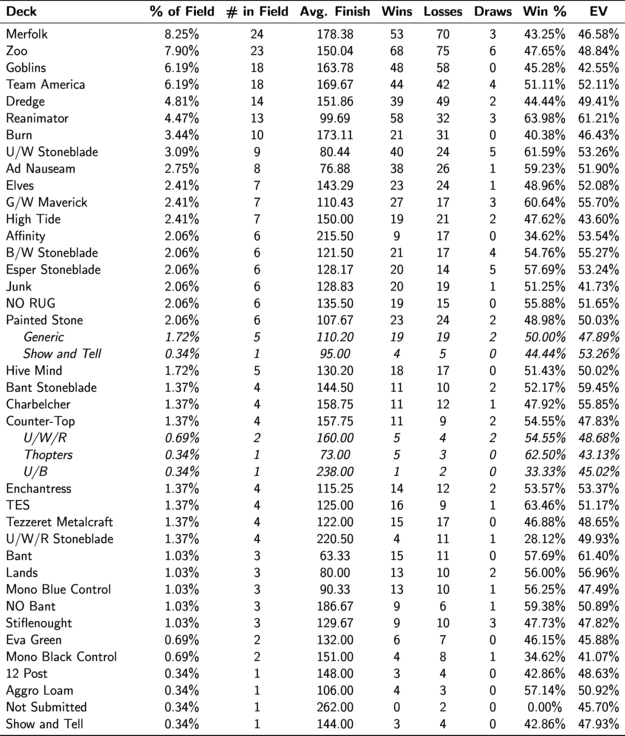
What should immediately stand out is the relative absence of U/W Stoneblade and NO RUG, the two best-performing decks during the month preceding the banning. Both decks plummeted in popularity, which might be expected (Mental Misstep was arguably at its best in these archetypes), but both decks managed very strong performances, regardless. Whether this speaks to the viability of these decks in the post-Misstep metagame or to the abilities of the small group of players that refused to put them down is hard to tell.
Merfolk remained the most-played deck in Indianapolis, but only by a single player; Zoo was very nearly as popular. Both decks struggled to win matches though, with Merfolk in particular underperforming its EV and posting a dismal win percentage.
There has been some talk about Goblins being poised to benefit from the banning of Misstep, and it seems that players took that to heart in Indianapolis. Legacy’s original tribe surged to more than six percent of the field for the first time in many months. However, even though Goblins did better than its EV, the deck still won fewer than half of its matches.
Team America doesn’t look out of place at around six percent of the field, and its slightly positive win percentage is fairly typical as well. What is noteworthy about it is that TA was the only deck among the five most popular that had a positive record at all!
Dredge showing up as the fifth most popular deck is interesting, if not unheard-of. The same can be said for its win percentage, which was almost as miserable as Merfolk’s.
With the more popular decks failing, Reanimator’s awesome win percentage really stands out. It won more than 60% of its matches, which would be a fantastic result in any tournament, but here it makes Reanimator look like a clear best choice. It was certainly better than Burn, which a full ten people showed up with—only to find out why Patrick Sullivan is the only person who should play Lava Spike in Legacy.
As mentioned above, U/W Stoneblade also did very well, nearly matching Reanimator’s numbers.
After U/W Stoneblade, we see Ad Nauseam, with its eight pilots having a very good day of their own. Notice TES (The Epic Storm) farther down the list, also with a very good win percentage. The Indianapolis Open was apparently a good place to be playing Tendrils of Agony (or, at the least, a good place to not be playing one of the more popular decks).
The other Stoneblade decks, B/W and Esper, also enjoyed success. In the case of the Esper decks, we see more evidence that blue-based Stoneforge Mystic decks may not have suffered from the loss of Misstep as much as people think (although U/W/R Stoneblade did absolutely horribly).
So, Legacy certainly underwent some changes prior to the Open Series’ stop in Indianapolis. However, we think that the format remained in a state of flux even afterwards, as is evidenced by the following event in Nashville:
Nashville Legacy Open Breakdown
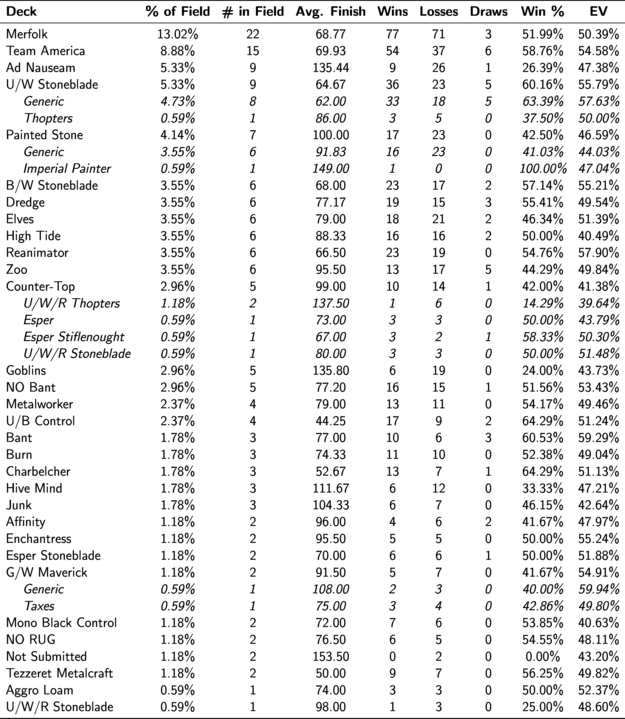
In Nashville, Merfolk reasserted itself as Legacy’s primary deck to beat, besting the next deck in field presence by more than four percentage points. It also performed much better than it did in Indianapolis, boasting a slightly positive record.
Team America’s rise to second most popular deck may have been due to its success in Indianapolis or to the hype surrounding Snapcaster Mage, but the deck’s great record in Nashville certainly helped its case.
Ad Nauseam tying U/W Stoneforge for third most popular deck may also have been due to its record in Indianapolis, but the Open Series competitors in Nashville were apparently much more prepared for Storm combo. Barely winning a quarter of its matches, Ad Nauseam posted a spectacularly bad result, especially for such a popular deck.
U/W, on the other hand, had another great weekend without Mental Misstep. Chris VanMeter deck in particular provides an example of how the archetype began developing post-Misstep.
Painted Stone sliding into the fifth spot in popularity was a bit of a surprise, even in a smaller event such as this. However, its results were not very impressive. Taken with Ad Nauseam’s disastrous record and High Tide’s tied record further down the list, these numbers suggest that combo simply wasn’t well-positioned in Nashville. This is in stark contrast to the Indianapolis event, in which combo enjoyed a great deal more success.
The next block of decks, with six players apiece, included several archetypes that we’re used to seeing as three or four percent of the field, and at least one that looked out-of-place. That standout was Zoo, which was almost tied for being the most popular deck in Indianapolis, but its poor performance there and the success of combo decks probably made it appear less attractive coming into this event. Its terrible win percentage, predicted by its EV, reinforced this. This environment was hostile to Wild Nacatl.
B/W Stoneblade soldiered on to post the best win percentage among these decks, which backed up its strong showing in Indy. Dredge also did well in Nashville, which countered a poor result in Indy. Reanimator, inexplicably less popular than it was in Indianapolis, couldn’t quite repeat its performance but had a solid record, nonetheless.
After being one of the most popular decks in Indy, Goblins was only played by five people in Nashville, and it was even worse for them. We can probably expect Goblins to remain outside of the upper tiers for the foreseeable future, even with Misstep gone.
Notice NO RUG, far down the list, with only two players having chosen it. Although those two participants managed a respectable record for the deck, it seems safe to say that the former powerhouse has suffered more from the loss of Misstep (at least, in popularity) than its compatriot, U/W Stoneblade.
Moving on, here is the field breakdown from Baltimore:
Baltimore Legacy Open Breakdown
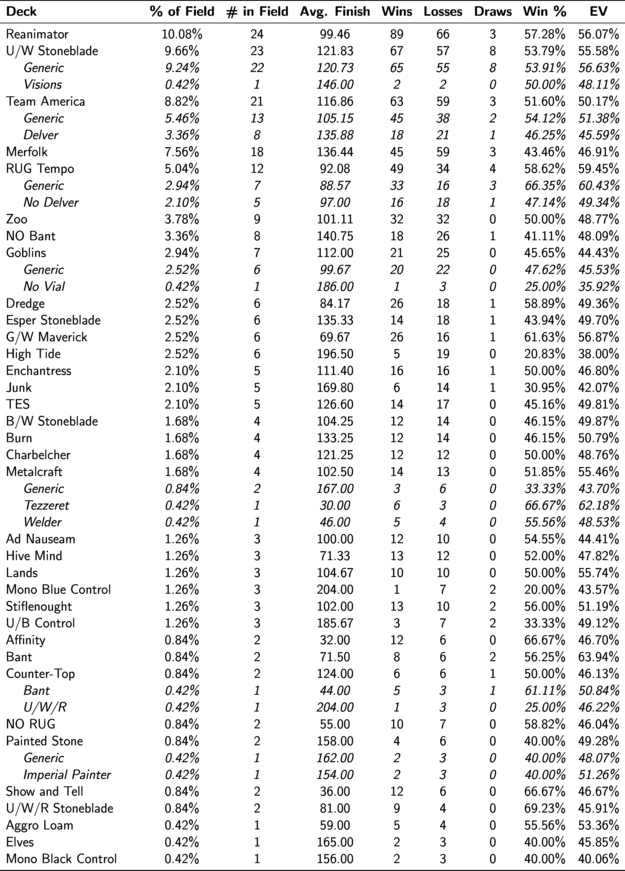
What’s that at the top of the chart? The fact that Reanimator was the most popular deck in Baltimore is confirmation of the deck’s upward trend since New Phyrexia brought it Jin-Gitaxias. It seems like the banning of Mental Misstep has only helped the deck out. Not only was Reanimator popular though; it also won an overwhelming majority of its matches. All in all, the deck dominated this tournament.
U/W Stoneblade is next on the list, and is only just behind Reanimator in representation. In terms of performance, U/W didn’t do quite as well, but a win percentage over 53% was still very respectable in this event. The banning of Misstep hasn’t knocked this deck out of the ring, although it is interesting to note that modern lists seem to have dropped Ancestral Visions.
Next up is Team America, which has already proven itself competitive in the post-Misstep format with strong finishes in both Indianapolis and Nashville. In Baltimore, the deck’s win percentage fell to a more mediocre number, perhaps because it struggles against the most popular deck in the field, Reanimator.
It may seem strange to see Merfolk sliding down in popularity, but the deck’s inability to win matches probably explains this decline. After struggling in Indy and Nashville, another bad weekend for the fish should make us question—not for the first time—if Merfolk’s time in the spotlight is coming to an end.
At just over five percent of the field, RUG Tempo stands out more for its great win record than for its popularity. Although this deck certainly has roots in the Canadian Threshold lists of the past, it is Lewis Laskin take on the archetype, with the new additions of Delver of Secrets and Snapcaster Mage, that surfaced in Baltimore. The category should also include Calosso Fuentes’ winning Counterbalance list.
The rest of the field contains many of the usual suspects, with a few standouts. Dredge and G/W Maverick are worth noting for having very high win percentages, but they only had six players apiece. TES and Ad Nauseam failed again to recreate the success or popularity they enjoyed in Indianapolis. Esper Stoneblade and B/W Stoneblade also did poorly.
It looks like the deck to beat in Baltimore was probably Reanimator, but the real story of the tournament would turn out to be the rise of RUG Tempo. Let’s move on to Kansas City:
Kansas City Legacy Open Breakdown
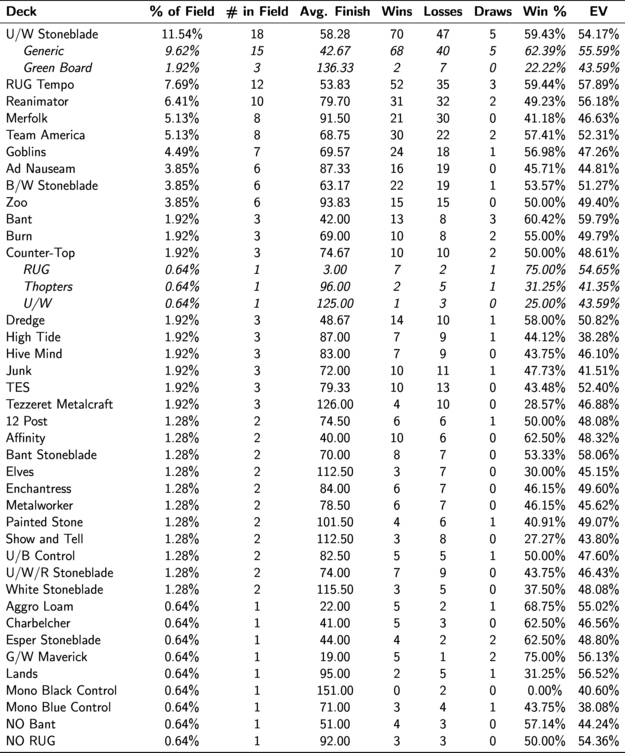
U/W Stoneblade being the most-played deck is no surprise, but it having such a high win percentage is a little less expected. What’s even more interesting is RUG Tempo falling just behind in popularity, and almost exactly matching the performance. These two decks crushed Kansas City.
It seems that people came more prepared to face Reanimator this time. Instead of posting another fantastic record, it actually lost one more match than it won. Looking further down the chart, we see that Dredge also did much worse than it did in Baltimore; were players in Kansas City simply packing more hate for graveyard-based strategies?
This event is another notch in Merfolk’s downward trend. Just over five percent of the field, the deck won barely 40% of its matches. It seems that modern blue decks have adapted to answer Lord of Atlantis, now that Mental Misstep isn’t around to protect it.
With the same field presence as Merfolk, Team America looks a little unpopular as well, but it still had a fantastic weekend. The deck nearly matched the win percentages of U/W and RUG.
Surprisingly, Goblins also enjoyed success in Kansas City. The red tribal deck did very poorly in the three prior tournaments, but boasted a very positive win percentage in this event.
We can clearly see that U/W Stoneblade and RUG Tempo were the cream of the crop this time. The three people who played Bant might disagree, but the two most popular decks in the room outperformed nearly everything else, and that is quite a feat. Let’s move on to Las Vegas:
Las Vegas Legacy Open Breakdown
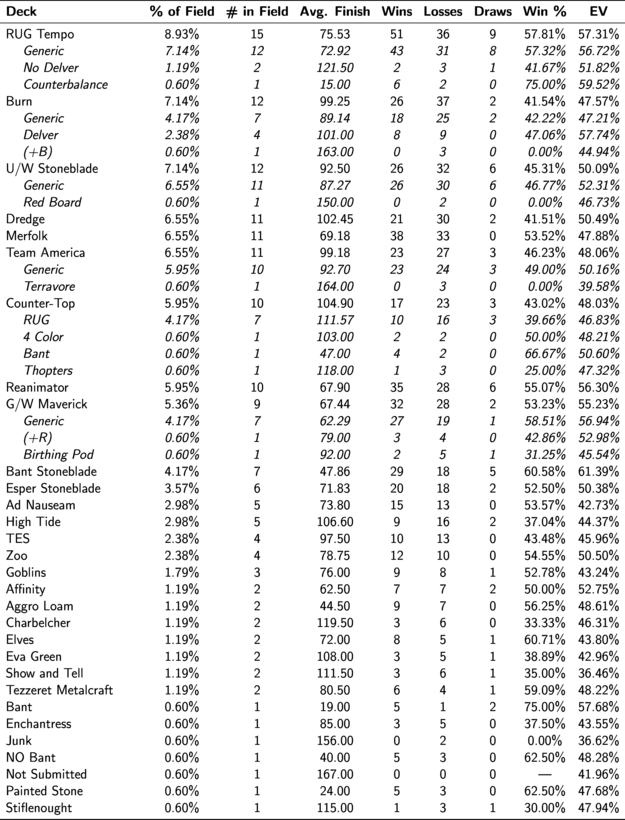
After breaking out in Baltimore, it only took two more events for RUG Tempo to seat itself as the most popular deck in the format. Not only that, RUG also maintained an incredibly high win percentage, much higher than the next several decks on the list.
If you did a double-take seeing Burn tied for second most popular deck, you aren’t alone, but there’s nothing surprising about the deck’s performance. Few decks have consistently put up such dismal numbers as Burn, but it remains relatively popular, likely because of its accessibility.
The fact that U/W Stoneblade switched positions with RUG Tempo is probably less interesting than U/W’s uncharacteristically poor results. This is the first time U/W posted an unfavorable win percentage since the loss of Mental Misstep.
After a two-way tie for second most popular, we have a three-way tie for fourth. This is the second event in a row in which Team America and Merfolk were each played by the same number of people, and this time they are joined by Dredge. The most notable result among these decks is probably Merfolk’s positive record, its first since the banning. Team America’s poor performance is also unusual though, and even Dredge’s percentage is particularly bad.
It has been some time since Countertop has made up more than five percent of an Open field. It’s presence in Las Vegas probably can be attributed to Gerry Thompson Top 8 in Kansas City, as well as the presence of the soft-lock in some RUG Tempo lists, such as Calosso’s from Baltimore and Jason Golliher’s list from Kansas City. Unfortunately, there is probably some confusion in the categorization of these decks, but we can at least see that Countertop, in general, did not perform very well in Las Vegas.
Reanimator didn’t drop much further in popularity from Kansas City to Las Vegas, but several decks that became more popular jumped above it on the chart. Despite this, the deck managed another strong result, and is one of the few decks in the tournament that challenged RUG Tempo’s dominance.
Another one of those decks is G/W Maverick, which had a strong win percentage that gets much stronger if you limit your attention to generic lists. Those seven players won more than 58% of their matches.
A group of seven players who did even better were those playing Bant Stoneblade, winning more than 60% of their matches.
The interesting thing about the Las Vegas Open is that most of the popular decks did poorly. After RUG Tempo, you have to look halfway down the chart to see any decks that enjoyed comparable success. Of course, all this means is that the Legacy format is full of powerful decks that don’t all see a lot of play at one time, and that preparing for such an unpredictable field can be a considerable challenge.
RUG Tempo ? 3.82% of field ? won 58.61% of matches
Example: Jonathan Job, Las Vegas Open, 1st place

Prior to the banning of Mental Misstep, Legacy found itself in the grip of another RUG deck—NO RUG. Although the new RUG Tempo decks pursue a very different gameplan than one revolving around Natural Order, they do employ several of the same tactics by nature of sharing the same color combination. Of course, two cards from Innistrad—Delver of Secrets and Snapcaster Mage—are key components in this new archetype. Arguably, Brainstorm and Lightning Bolt work even better alongside these two blue creatures than they ever did next to Green Sun’s Zenith and Natural Order.
RUG Tempo, as we often wrote about NO RUG, had the best win percentage amongst the popular decks in these tournaments. Looking at RUG Tempo’s matchups, you can see what has made it a fearsome competitor. It has strikingly favorable records against Merfolk, Team America, and Reanimator. It does face a significant struggle against U/W Stoneblade, though.
U/W Stoneblade ? 6.95% of field ? won 56.21% of matches
Example: Matthew Langford, Kansas City Open, 9th place

As for U/W, itself, it also displays some impressive numbers. Aside from the aforementioned matchup against RUG Tempo, which is likely the most important matchup in Legacy right now, U/W also crushes Merfolk and maintains a healthy advantage over Reanimator. Only the Team America matchup is unfavorable, and it is very close, at that. U/W’s overall win percentage was also terrific.
Reanimator ? 6.16% of field ? won 56.91% of matches
Example: Tony Murata, Las Vegas Open, 3rd place

After an impressive run in Indianapolis and a dominant performance in Baltimore, Reanimator fell back a little in field presence, but its overall win percentage was still impressive. Before you decide to pick up the deck, look closer at its individual matchups. Reanimator clearly has trouble with U/W Stoneblade and a severe problem against RUG Tempo. The Merfolk matchup is just about even, and the Team America matchup is very good, but both of those decks have given way to U/W and RUG in popularity. If you do choose to play Reanimator, you’re banking on picking up a lot of percentage points by beating less popular decks.
Merfolk ? 8.12% of field ? won 47.13% of matches
Example: Andres Cifuentes, Las Vegas Open, 12th place

Throughout the Mental Misstep era, Merfolk remained a popular and mildly successful deck, although its numbers had a tendency to swing wildly from one event to the next. Across these five tournaments though, the deck’s numbers were relatively consistent, and they were not good. It remained the most popular deck, barely, but its overall win percentage was well below 50%.
We see here that, although Merfolk was one game ahead against Reanimator, it was heavily unfavored against each of the other popular decks. The fact that those are all blue-based aggro-control decks, which are precisely the types of decks Merfolk traditionally preys on, definitely suggests that the metagame has adapted to push Merfolk out of its niche. Whether the fish will continue to slide into a non-competitive tier depends on how the format continues to develop.
Team America ? 7.14% of field ? won 53.22% of matches
Example: Alex Gonzalez, Kansas City Open, 2nd place

Across these tournaments, Team America was never the most popular deck, but its consistent presence leaves it just behind Merfolk as the second most played deck, overall. TA’s win percentage was solid, if unexciting, and its matchup breakdown follows suit. It was slightly ahead against U/W, and a little further ahead against Merfolk, but it is well behind against RUG Tempo and Reanimator. With these results, we can probably expect a lot of TA pilots to switch to one of the more successful blue decks in the future.
As we head into Charlotte, North Carolina for the Invitational and the last Open tournament of 2011, it appears that RUG Tempo and U/W Stoneblade are the defining decks of Legacy. Both decks are on fire right now, and are as likely as any to put multiple players into the elimination rounds of those tournaments.
However, Reanimator and Team America will be present as well, and also have good chances to perform in the hands of experienced pilots. Less-known possibilities include G/W Maverick and Bant decks, which may be well-positioned but have yet to pick up in popularity.
We’ll find out this weekend. Hope to see you there!
Alix and Jesse Hatfield
